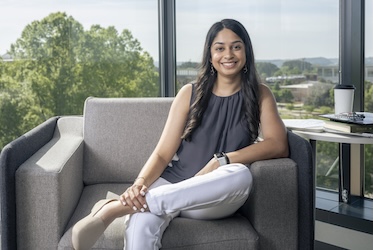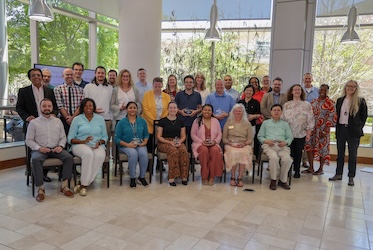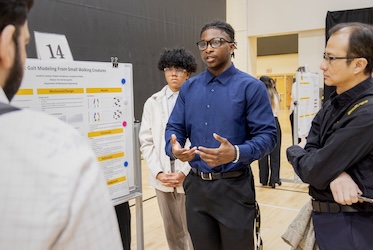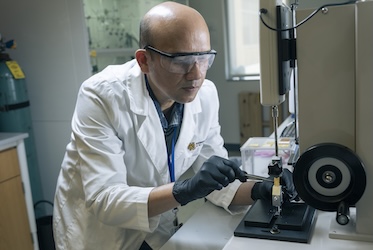
Researcher focuses on insect interactions
KENNESAW, Ga. | Oct 14, 2020
Kennesaw State University’s Office of Research is hosting a one-hour web show every other Friday at 4 p.m. to showcase the varied research being conducted by KSU faculty members. “Research with Relevance” spotlights Kennesaw State researchers in a live interview followed by an interactive question-and-answer session with the virtual audience.

How did you first get involved in this field of research? / When did you decide to become a researcher?
People who become insect biologists often have stories about catching and identifying bugs as soon as they were old enough to walk. That was not me. When I was growing up, I was more interested in skateboarding and punk rock than anything bug-related. But I did name my first punk band the Army Ants, so there must have been some early interest there.
I became interested in ants when I was studying biology in undergrad. Ants have evolved societies with many parallels to our own — they have garbage workers, soldiers, nurses, a police force, and highway maintenance crews. So many interesting facets of ant societies reflect back on our own, from the way they communicate with each other to how they fight the spread of disease within their colonies. And ants also play important roles in the health of our ecosystems: ants turn more soil than earthworms, they form mutualisms with plants and protect them from pests, they disperse seeds, and they even help us keep our streets clean from litter.
Who has influenced you, either as an instructor or as a researcher?
My favorite professor during undergrad was Dr. Walter Tschinkel at Florida State University, who happened to also be the world’s foremost expert on fire ants. I took every class that Walter taught, and when there were no more classes I could take, I asked if I could work in his lab. After that, I would come home every day with fire ant stings up and down my arms, but I loved the work and getting to do real research.
What was the defining (or ‘aha”) moment when you realized this is what you wanted to do?
When it came time for me to do an undergraduate thesis, I knew I wanted to do something with ants. What I soon realized was that you could study ants pretty much anywhere. My first published paper was based on experiments I conducted in my front yard. The idea that you could study ants anywhere has stuck with me throughout my career, and I’ve now studied ants in areas that have ranged from the jungles of India to the streets of New York City.
In what ways has KSU supported your research?
The Office of Research has been instrumental in helping me prepare and submit grant proposals even before I arrived at Kennesaw. I submitted my first proposal from my laptop while driving across the country to move here, and it got funded!
How are you involving students in your research? / How have you seen students benefit from being involved in your research efforts?
My first group of undergraduate students have been identifying ant species collected from cities across the U.S. Ant identification is not easy—you literally have to count the hairs on an ant’s back to tell some species apart. I’ve been amazed to see how quickly my students have picked it up, and we’re now working on our first paper that will have five KSU undergraduate co-authors.
What do you hope students learn from you in the classroom?
I recently asked a group of my non-scientists friends about what they remembered from biology, and they all repeated in unison: Mitochondria is the powerhouse of the cell! If that’s all my students remember from my classes, then I’ve failed. I hope my students learn how to critically think, evaluate complex information, and ask interesting questions. And above all, I hope they stay interested in science and continue to be excited by discoveries that are happening every day.
What is a common misconception about your field?
People always ask me if it hurts getting bit by ants. Well, ants don’t bite, they sting. And yes, it hurts when you get stung! I’ve had the honor of being stung by the world’s most painful ant—the bullet ant—and it took three days for the pain to fully go away.
How much has your field changed in the time you’ve studied it?
When I started in biology, I thought you had to travel someplace far away to find interesting species. Now I know that interesting species live practically everywhere—in our cities, in our homes, and even on our bodies. I have colleagues who study cave crickets that live in basements, bacteria that live in our belly buttons, and mites that live on our eyelashes. It has been exciting to see the growing number of biodiversity studies happening close to home, and I think more people are becoming aware of the role humans have in shaping our environment.
Tune in on Friday, October 16 at 4 p.m. to hear Penick talk about his research and answer your questions. Click here for more information.
Related Stories
A leader in innovative teaching and learning, Kennesaw State University offers undergraduate, graduate, and doctoral degrees to its more than 47,000 students. Kennesaw State is a member of the University System of Georgia with 11 academic colleges. The university’s vibrant campus culture, diverse population, strong global ties, and entrepreneurial spirit draw students from throughout the country and the world. Kennesaw State is a Carnegie-designated doctoral research institution (R2), placing it among an elite group of only 8 percent of U.S. colleges and universities with an R1 or R2 status. For more information, visit kennesaw.edu.





















